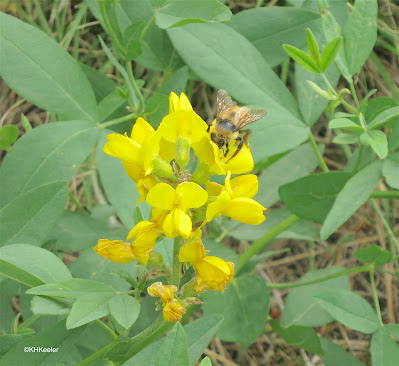The name golden banner seems obviously based on being a highly visible yellow flower, but in fact, banner is also a technical term used to describe one of the parts of the pea flower (link), the uppermost part, so you can also understand the common name as being descriptive, "you know, over there, the flower with the golden banner."
Its scientific name relates it to lupines (genus Lupinus), thermos being Greek for lupine and opsis meaning "like." Some places the common name is given as false lupine.
The genus Thermopsis has about 15 species and is found across North America and Asia. There is debate about how many different species of golden banner there are in the U.S. The USDA Plants list gives 11. Ackerfield in the Flora of Colorado found continuous variation between the three species reported from Colorado and so merged them all into Thermopsis rhombifolia, calling the other forms subspecies. I could not find that anyone has studied the problem beyond Colorado. The species epithet rhombifolia means with rhombic (the four sides the same length but angled, not square link )-shaped leaves.
[Botanical Details: When to call it one species or two is tricky when there are intermediates; maybe two distinct species hybridize when they meet, forming intermediates, but, alternatively, maybe one widespread species has local, variant forms in some areas. A species is usually defined as a group of organisms that are interfertile with each other but not members of other species. A little hybridization at the edge of the range is typical of plants, but when there are a lot of intermediates, botanists tend to call it all one species (though usually reluctantly, because widely distributed variable species are so, well, messy.) Species are real, but they are forever evolving; at any particular time, some plant species will be part way to becoming to two (or more) species that at some future time will be quite separate. Those cases are problem ones. If you are an evolutionary biology researcher, you are fascinated by the hard-to-classify cases (ooh, what is going on here?!); if you are a user of plant names, you just accept that some groups are, for good biological reasons, hard to classify.]
Golden banner plants spread from rhizomes, so can cover large areas if they like the conditions. They prefer shade, making them a handsome ground cover for shade in Colorado, where attractive native ground covers are relatively few. In a few years, you are likely to be pulling the plants out from beds where they are unwelcome, which I prefer to having my ground cover slowly die out.
The flowers are very attractive to bees.
I compared them to peas above, but unlike peas, golden banner is poisonous to eat, so a better comparison is to lupines, which are generally toxic.
Native Americans (Navajo, Blackfoot) made medicine for sore eyes from golden banner and inhaled the smoke of dried leaves for headaches.
But, especially, they watched for golden banner flowers as a sign of the changing seasons. When golden banner flowered, the Blackfoot and Flathead knew it was prime buffalo hunting season. Across its range, golden banner flowers from April to August, so to use it as a calendar marker, you have to know your local golden banner, as the Blackfoot and Flathead did.
 |
| I enjoyed watching that bumblebee |
A very nice American wildflower.
References
Ackerfield, J. 2015. Flora of Colorado. BRIT Press, Fort Worth, Texas.
Missouri Botanical Garden. Thermopsis villosa. Missouri Plant Finder link (Accessed 6/29/20).
Kathy Keeler, A Wandering Botanist
More at awanderingbotanist.com
Join me on Facebook: https://www.facebook.com/AWanderingBotanist



Pretty but toxic to cattle.
ReplyDelete